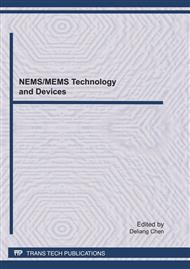p.159
p.163
p.167
p.171
p.175
p.179
p.183
p.187
p.191
Simulation Study of Side-by-Side Spiral Coil Design for Micromagnetometer
Abstract:
Magnetic field measurement has many applications particularly in the field of navigation, military, space exploration, and medical. Among many magnetic devices, magnetometer is significant due to its capability of detecting direction and measuring strength of magnetic field. Through the years, many types of magnetometer had been invented with fluxgate magnetometer being one of the most well-known. In the advances of MEMS processing technology, fluxgate magnetometer is increasingly developed into micro-scale. Fluxgate magnetometer is made up of three major components consisting of sensing coil, driving coil and magnetic core. The physical characteristics of the coil structure play an important factor in miniaturization as well as in performance of the device. Therefore, investigations on the physical characteristics of the coils are relevant. In this paper, the side-by-side spiral coil structure is investigated in terms of its physical characteristics such as width of the coil and distance between successive coils. The aim is to observe and analyze the effects of varying the coil physical characteristics on certain important parameters that could influence the performance of the device. The work is done with the aid of FEM simulation software, where the physical characteristics of the coils were varied and simulated. With the simulated results, dimension of coils can be appropriately designed to optimize the performance of the device.
Info:
Periodical:
Pages:
175-178
Citation:
Online since:
May 2011
Authors:
Keywords:
Price:
Сopyright:
© 2011 Trans Tech Publications Ltd. All Rights Reserved
Share:
Citation:


